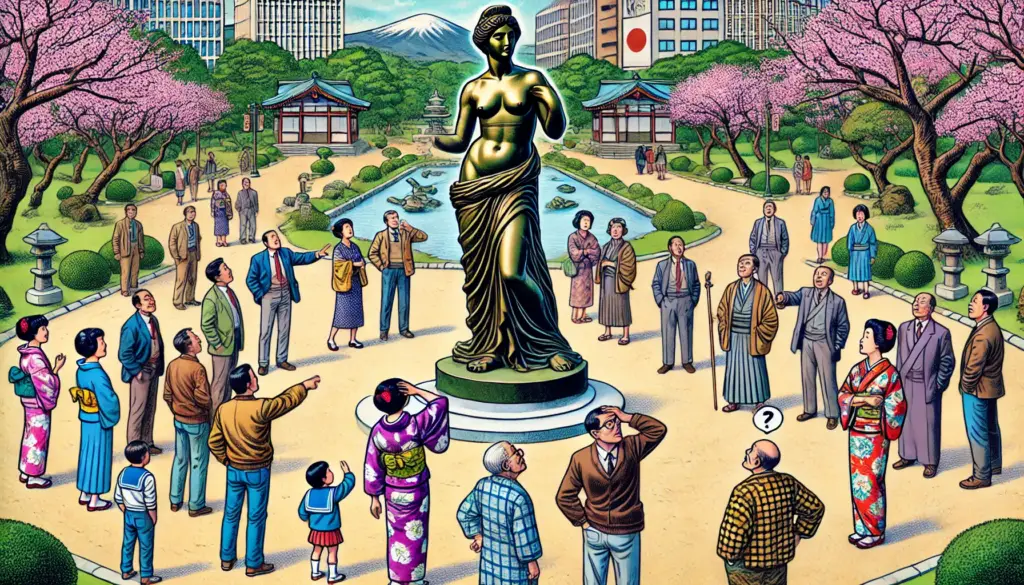
Introduction
Walking through Japanese parks, city squares, and hot spring towns, one might be surprised by the number of nude female statues on public display. From elegant bronze figures to modern stone carvings, these artworks were once considered symbols of beauty, vitality, and cultural refinement. Yet in recent years, criticism has grown louder. Some citizens have argued that such displays are outdated or even inappropriate in today’s social climate, prompting certain municipalities to quietly remove them.
This phenomenon raises an important question: Why did Japan embrace nude statues so widely, and why are they now facing backlash? To answer this, we need to explore the historical, cultural, and social contexts that shaped Japan’s unique approach to public art.
A Historical Overview: From Postwar Optimism to Local Pride
1. The Postwar Boom and Artistic Renaissance
After World War II, Japan entered a period of rapid reconstruction and cultural reinvention. During the 1950s to 1970s, many local governments invested in public art projects to symbolize modernity and optimism. Nude statues, particularly of women, were seen as representations of fertility, peace, and universal beauty.
Unlike in some Western societies, where nudity in art is often tied directly to classical ideals of democracy or the Renaissance, in Japan it was connected to purity and nature. Sculptors and local authorities believed that displaying nude figures outdoors harmonized human beauty with natural surroundings, making parks and plazas feel more vibrant.
2. The Economic Bubble and “Cultural Infrastructure”
During the 1980s economic bubble, municipalities competed to beautify towns and attract tourism. Public art was funded generously, and nude statues became a popular choice. For many small towns, commissioning such works became a status symbol, demonstrating cultural sophistication and financial health.
It was not unusual for hot spring resorts (onsen towns) to showcase statues of nude women near baths, reflecting traditional associations between nudity, relaxation, and health.
Cultural Perspectives on Nudity in Japan
1. A Different Lens than the West
In the West, nudity often carries a sexual undertone. In contrast, Japan historically viewed communal nudity, such as in public baths, as natural and non-sexual. This cultural background made nude statues less controversial in the past.
For example:
- Onsen culture normalized the idea of unclothed bodies in shared spaces.
- Shinto traditions emphasize purity, and nudity was sometimes linked to innocence rather than taboo.
- In Japanese aesthetics, the human body was seen as an extension of nature, not something inherently shameful.
2. Gender and Representation
However, critics have pointed out that the majority of these statues depict female nudes, reinforcing a male-centered perspective of beauty. While intended as tributes to femininity, some now interpret them as outdated symbols of objectification.
The Growing Backlash
1. Changing Social Values
In the 21st century, Japan’s society began rethinking issues of gender equality and representation. What was once accepted as art began to be questioned: Why are so many statues of nude women, and so few of men?
With the rise of feminist perspectives and international discussions about the portrayal of women in public spaces, local residents and activists started demanding change.
2. Removal by Municipalities
Some municipalities have quietly removed statues after receiving complaints. For example, towns that once proudly installed nude statues in front of schools, stations, or city halls later reconsidered, fearing they might be seen as insensitive or outdated.
This reflects a broader cultural shift: what once symbolized progress is now, in some cases, regarded as inappropriate.
The Debate: Preservation vs. Removal
1. Arguments for Preservation
- Historical value: These statues are part of Japan’s postwar cultural history.
- Artistic freedom: Removing them may be seen as censorship.
- Cultural uniqueness: They reflect Japan’s distinct view of nudity compared to Western norms.
2. Arguments for Removal
- Changing norms: Public spaces should reflect contemporary values.
- Gender imbalance: Overrepresentation of female nudes reinforces stereotypes.
- Misinterpretation by tourists: Visitors unfamiliar with Japan’s cultural context might see the statues as inappropriate.
What Makes Japan Different?
Japan’s nude statues cannot simply be compared to those in European capitals. In Europe, nudity in art often ties back to classical antiquity, while in Japan, it was linked to modernization, local pride, and integration with nature.
This explains why the statues appeared not only in big cities but also in rural towns, hot spring resorts, and even small community squares. They were not merely copies of Western ideals but became embedded in Japanese cultural identity.
The Future of Nude Statues in Japan
Japan now stands at a crossroads. Some statues will likely remain, appreciated as cultural artifacts, while others may be relocated or removed. In the future, we might see:
- Reinterpretation through plaques or exhibitions that explain their historical context.
- More balanced representation, including male figures or abstract forms.
- Greater community involvement in deciding what kind of art belongs in public spaces.
Rather than erasing them completely, Japan could use this debate as an opportunity to redefine public art for a new era, blending respect for history with sensitivity to current values.
Conclusion
The abundance of nude female statues across Japan is not a coincidence but the result of specific historical, cultural, and social conditions. They reflected optimism, artistic pride, and a unique cultural perspective on nudity. Yet as society evolves, so do perceptions of what is appropriate in shared spaces.
The debate over these statues is not just about art—it is about how Japan negotiates tradition, modernity, and global perspectives on gender and representation. Whether preserved, removed, or reinterpreted, these statues continue to reveal as much about today’s Japan as they do about its past.



















































